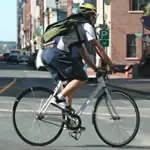Bike For a Better Commute
By Zack Vestal
VeloNews
When you think of someone riding a bike to work, what’s the first image that comes to mind?
Probably a rugged, solitary wheelman, wrapped in a wind-whipped nylon jacket and sweat-stained leather gloves, crowned with a 1975 Bell Biker hardshell helmet. Maybe he’s even sporting a reflective orange safety vest.
He’s slowly churning through a grey morning mist, grinding the rusty chain of a geriatric Stumpjumper into the flickering beam of a dim headlight. Abundant toe straps, duct tape and bungee cords keep this gritty rider in place and his cargo lashed to a rattletrap cargo rack.
It’s time to overhaul your thinking. Commuting is cool, the gear is cool, and you don’t have to suffer. Sure, that guy is still out there. And he and his compatriots deserve respect.
They’ve probably been pedaling to work, around town, and on errands since the first energy crisis of the 1970s. They’ve been saving fuel, reducing pollution and staying healthy well before the current recession and global warming again made cycling a trendy transportation alternative.
But these days, riding your bike to work or to the grocery store doesn’t have to be an exercise in obsolete technology and crusty discomfort. In the last few years, even the major players in cycling have developed sweet, purpose-built bicycles, clothing and accessories that threaten to legitimize (or even popularize) what was once a fringe transportation mode.
“It’s huge; commuting is the future,” said Giant Bicycles communications manager Andrew Juskaitis. “The fastest growing segment, across the market, is flat handlebar road bikes, like our Defy,” which double as efficient and agile commuter bikes.
The return of bicycle commuting is timely. As Trek company president John Burke succinctly notes, “The bicycle is a simple solution to some of the world’s most complicated problems.”
Riding a bike to work, even occasionally, helps reduce air pollution, traffic congestion, and carbon dioxide emissions, while elevating fitness levels, reducing obesity and improving the livability of communities. It’s a low-cost, multi-pronged attack on some of the major ills that plague modern urban life.
Robbie Brennan, a manager at Mellow Johnny’s bike shop in Austin, says riding a bike is good for mental health, too. Commuters are generally “in a better mood than people that aren’t,” he said. It doesn’t hurt that Mellow Johnny’s pampers Austin commuters with coffee, bike storage, showers and route maps, but more and more shops and businesses are following suit in progressive cities.
Riding a bike now and then is also good for your bottom line. Pedal two or three times a week, and you’ll save on fuel, parking and vehicle maintenance costs, sometimes to the tune of hundreds of dollars annually.
Those spare ducats could fund a few extra race entries this season. Not to mention the training benefit of pedaling the easy miles to shake a weekend’s worth of hill repeats out of your legs.
Are you convinced? Is it time to start riding to work, even just once a week? We think so. Here’s how.
Homework Assignment: Plan Your Route
Before diving in and buying a new road bike with lights, fenders and panniers, consider the possible paths from your home to your workplace. The route you choose and the conditions you encounter will inform your bike and gear selections. And maybe you’ll discover that some form of public transportation or a mixed commute will be necessary.
“‘Plan the route’ is number one,” suggested former professional mountain bike racer Chris Eatough. He’s now a program manager for Bike Arlington, a transportation initiative of Arlington County, Virginia. “Some people don’t know or don’t realize or don’t have great routes to get from A to B,” he said. “Definitely figure out the best route to have a safe and pleasant ride.”
Eatough lives 35 miles from the office, so he splits his commute. “I drive about 30 minutes and I ride about 45 minutes,” he said. “The nice thing there is that I can pick the starting point for my ride, so I park at the end of a bike trail that we have that goes all the way from where I start to where the office is located. I get to do the whole ride on a bike on a bike trail with no traffic, no cars, and it’s a really pleasant ride.”
Many people have shorter trips, of course. “Two or three miles is perfect,” he said. “Often the fastest way is to go by bike if you’re going a short distance like that.”
With a little research, it’s easy to find bike paths, shortcuts and back roads that are impassable by car. Check out a local bike route map, consult with your local alternative transportation agency or do your research online.
“Most areas have a decent bike map, which is not focused on roads, but focused on which roads have bike lanes and separated bike paths,” Eatough said.
New online tools are cropping up. For those in New York, Chicago and Austin, a new site called Ride the City is like a Google Maps for cyclists. You enter your start and finish points and it gives you a recommended bike route, prioritizing bike lanes, paths and safe roads.
Tip: As you get closer to nailing down a route, do extra legwork on the weekends to explore and confirm potential routes as you are coming back from your training ride. Just remember weekday traffic might look different.
Ready to Roll: You’ll Need a Bike
Your easiest, most cost-effective option is to ride the bike you already own. If you’ll ride to the office only occasionally and in good weather, and if you have safe storage for it, then your carbon fiber Colnago might be just the ticket. Just mix in two parts sturdy tires, one part blinky lights, and serve with a capacious backpack and a change of clothing.
However, riding to work more often involves traffic, bad weather, lousy roads and other hazards that your race bike will find distasteful. A dedicated transit bike will be more suited to the task, and having it ready at hand will make you more likely to follow through.
Many ride-to-workers simply convert an old mountain or road bike and dress it up with fenders and lights. Cyclocross bikes make great commuters, because you can vary tire choice by season and fit gearing to suit your needs. At the lower and midrange, they usually have rack and fender mounts.
Likewise, any touring or brevet bike will have fitment for racks and fenders, but will have a familiar road bike feel and more powerful caliper brakes.
If you really want to commit, go buy a commuter bike. Mellow Johnny’s manager Brennan said he usually steers people toward a city bike or hybrid bike. “It’s a little more upright, has eyelets for racks, and the wheels are a little fatter than what you find on a road bike, so you can load it down a little more,” he said.
Purpose-built urban and commuter bikes these days often have low-maintenance drivetrain solutions, disc brakes, racks, lights and fenders. Product manager JT Burke at Breezer Bicycles thinks your commuter bike should be fully tricked out. All but one of Breezer’s commuter bikes come with generator-powered lights that will never need batteries.
“A big part of Joe Breeze’s vision is what [accessories] bikes need to be truly useful,” he said. “We want our bikes to be a viable car alternative.”
Tip: If your route will include a gravel path, or if you might ride through snow in winter, get a bike with 26-inch wheels and clearance for knobby mountain bike tires. If on the other hand you expect to ride mostly pavement and open roads, a lighter bike with 700c wheels will roll faster and more efficiently.
Final Preparation: Clothing and Cargo, Lights and Lock
Arriving to the office in comfort and style will depend on the clothing you choose and your ability to carry cargo. Helmet, glasses, gloves and shoes go without saying, but a few pieces of equipment are commute-specific.
For a longer ride, a proper jersey, jacket and bib shorts are the way to go. In this case, your outfit needn’t be any different from what you’d wear on a training ride. You’ll have to carry a change of clothing or keep slacks and a shirt at the office. Many dedicated bicycle commuters drive to work a few times per week and leave wardrobe options behind for the days on which they pedal.
If you’ve got a shorter bike ride, or want to keep it simple, check out versatile options in technical pants and shirts. High-tech fabrics and smart sewing have blurred the line between casual trousers and water resistant, breathable riding gear.
Next to clothing, carrying your laptop, lunch and supplies is the most important consideration. A backpack is the obvious choice for short trips. Just be sure to get one that’s waterproof. For longer trips, a rack and panniers will carry your load more comfortably.
More businesses are offering bike parking or bike lockers for employees, but if not, you should be prepared to lock your bike outside. In a high-risk neighborhood, multiple Ulocks might be necessary, but often a stout cable lock will do the trick.
Finally, don’t leave home without front and rear lights. Daylight or not, flashing lights are critical for safety and visibility, and a good headlight will tunnel through the darkness. Even in the middle of summer with long daylight hours, you never know when you might be delayed in heading home.
Tip: Pair a flashing front safety light with your primary headlight. A lightweight, rechargeable LED headlight is by far the best way to light your way, but the steady beam isn’t visible enough to oncoming traffic. To be seen, you need something that flashes. Drivers can’t ignore flashing LED lights.
Online Resources
www.1world2wheels.org
Trek Bicycles’ effort to promote sustainable transportation includes tips and suggestions on going by bike
www.ridethecity.com
Bike routes through major U.S. cities
www.bikeleague.org
The League of American Bicyclists has long been committed to promoting cycling for fun and transportation
www.bicyclinginfo.org
The Pedestrian and Bicycle Information Center (PBIC) is a national clearinghouse for information about health and safety, engineering, advocacy, education, enforcement, access and mobility for pedestrians (including transit users) and bicyclists
www.bikecommuters.com
A frequently updated blog with loads of great info and commuter gear reviews
www.bicycletimesmag.com
A new magazine dedicated to commuting, from our colleagues at Dirt Rag
www.commutebybike.com
Tips, news, reviews and safety for bike commuters







